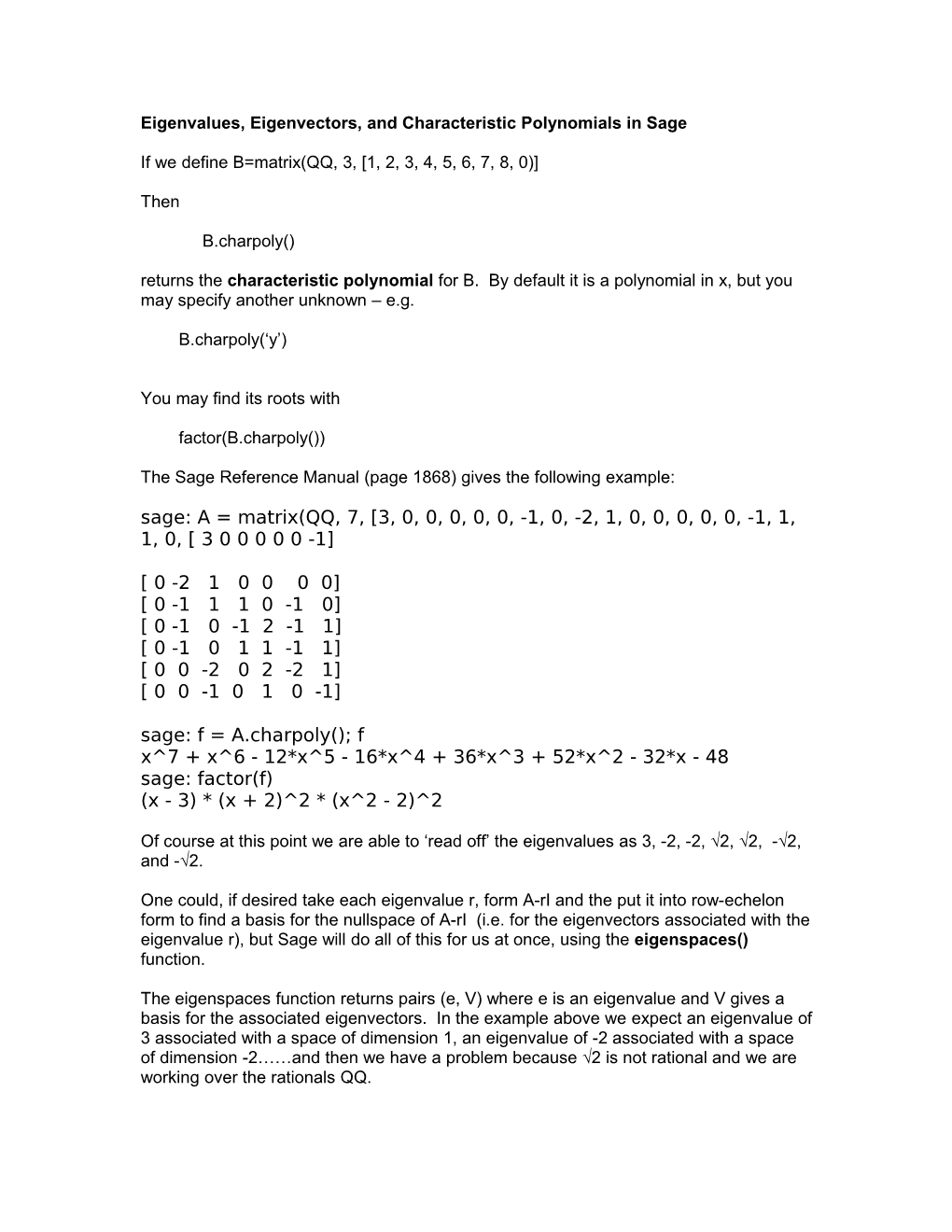Eigenvalues, Eigenvectors, and Characteristic Polynomials in Sage
If we define B=matrix(QQ, 3, [1, 2, 3, 4, 5, 6, 7, 8, 0)]
Then
B.charpoly()
returns the characteristicpolynomial for B. By default it is a polynomial in x, but you may specify another unknown – e.g.
B.charpoly(‘y’)
You may find its roots with
factor(B.charpoly())
The Sage Reference Manual (page 1868) gives the following example:
sage: A = matrix(QQ, 7, [3, 0, 0, 0, 0, 0, -1, 0, -2, 1, 0, 0, 0, 0, 0, -1, 1, 1, 0, [ 3 0 0 0 0 0 -1]
[ 0 -2 1 0 0 0 0]
[ 0 -1 1 1 0 -1 0]
[ 0 -1 0 -1 2 -1 1]
[ 0 -1 0 1 1 -1 1]
[ 0 0 -2 0 2 -2 1]
[ 0 0 -1 0 1 0 -1]
sage: f = A.charpoly(); f
x^7 + x^6 - 12*x^5 - 16*x^4 + 36*x^3 + 52*x^2 - 32*x - 48
sage: factor(f)
(x - 3) * (x + 2)^2 * (x^2 - 2)^2
Of course at this point we are able to ‘read off’ the eigenvalues as 3, -2, -2, √2, √2, -√2, and -√2.
One could, if desired take each eigenvalue r, form A-rI and the put it into row-echelon form to find a basis for the nullspace of A-rI (i.e. for the eigenvectors associated with the eigenvalue r), but Sage will do all of this for us at once, using the eigenspaces() function.
The eigenspaces function returns pairs (e, V) where e is an eigenvalue and V gives a basis for the associated eigenvectors. In the example above we expect an eigenvalue of 3 associated with a space of dimension 1, an eigenvalue of -2 associated with a space of dimension -2……and then we have a problem because √2 is not rational and we are working over the rationals QQ.
Sage treats roots of the characteristic polynomial outside the rationals as ‘irreducible’ and gives them names. (Sage does the same thing for complex roots when you are working over the real numbers RR.)
The default names for the irreducible roots are a0, a1 etc. but you may change the name, for example, to r0, r1 etc. by asking for A.eigenspaces(‘r’) . (Note the quotes around r.)
Continuing on with the Reference Manual’s example, we see:
sage: A.eigenspaces()
[
(3, [
(1, 0, 1/7, 0, -1/7, 0, -2/7)
]),
(-2, [
(0, 1, 0, 1, -1, 1, -1),
(0, 0, 1, 0, -1, 2, -1)
]),
(a2, [
(0, 1, 0, -1, -a2 - 1, 1, -1),
(0, 0, 1, 0, -1, 0, -a2 + 1)
])
]
This is a little odd ---- because while we got the eigenvectors associated with a2=√2, we never got those associated with -√2, .
My first thought was ‘Oh, I’ll avoid that by working over the real numbers’ – then the square root of 2 will be valid eigenvalue. This does work with the following caveat. Sage wants you to be aware that the eigenvalue you found is inexact. So you must say
A.eigenspaces(even_if_inexact=True)
Sage will prompt you for this if you forget.
Unfortunately, you won’t necessarily get the right answers! So the bottom line is that you need to do something else when your eigenvalues are irrational!
The Sage Constructions recommends that you use the interface with Maxima (p.27 – section 5.4) Here is the example from Constructions:
Another approach is to use the interface with Maxima:
sage: A = maxima("matrix ([1, -4], [1, -1])")
sage: eig = A.eigenvectors()
sage: eig
[[[-sqrt(3)*%i,sqrt(3)*%i],[1,1]],[1,(sqrt(3)*%i+1)/4],[1,-(sqrt(3)*%i-1)/4]]
This tells us that v1 = [1, (√3i + 1)/4] is an eigenvector of λ1 = −√3i (which occurs withmultiplicity one) and v2 = [1, (−√3i+1)/4] is an eigenvector of λ2 = √3i (which also occurs withmultiplicity one).
Here are two more examples:
sage: A = maxima("matrix ([11, 0, 0], [1, 11, 0], [1, 3, 2])")
sage: A.eigenvectors()
[[[2,11],[1,2]],[0,0,1],[0,1,1/3]]
sage: A = maxima("matrix ([-1, 0, 0], [1, -1, 0], [1, 3, 2])")
sage: A.eigenvectors()
[[[-1,2],[2,1]],[0,1,-1],[0,0,1]]
Warning: Notice how the ordering of the output is reversed, though the matrices are almost thesame.
The Constructions Manual also suggests using the GAP interface. As far as I can determine, the GAP they are referring to is the “Groups, Algorithms, Programming” initiative at more information on which is at It is not clear to me that this will handle irrational eigenvalues, so I would stick with the Maxima interface. (Maxima is built into Sage, as is GAP.)
